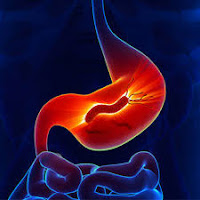Ulcers
Could My Municipal Water Supply Have The Bacteria That Causes Ulcers?
This is not very likely.
Even though very little is currently known about the epidemiology of Helicobactor pylori, the bacterium associated with stomach ulcers - it is believed that all standard disinfection methods used in the U.S. are capable of killing this organism in drinking water.
But here is what we understand most about this issue...
Dr. Katherine Baker, Assistant Professor of Environmental Microbiology and John Hegarty, a graduate student at Penn State Harrisburg, found H. pylori in more than 75 percent of 36 tested surface water samples in Central Pennsylvania.
This study is the first report of H. pylori in surface water in the United States, demonstrating a major reservoir for this organism outside the human body.
The results of the research were delivered on in May at the 98th General Meeting of the American Society for Microbiology in Atlanta, Georgia.
"Water looks to be a major factor in the transmission of the bacterium," Dr. Baker said, pointing out that the organism was found in both surface water and untreated groundwater from shallow wells where surface water contamination is likely to occur.
H. pylori was first described in the early 1980s by Australian researchers.
The organism is found in the stomachs of the majority of people in the world.
In a small percentage of individuals, the organism causes serious consequences.
It is now accepted that H. pylori is the cause of most duodenal ulcers and between 70 and 80 percent of gastric ulcers.
In the late 1980s, a link between H. pylori and certain types of stomach cancer was shown by researchers at Stanford University.
Epidemiological studies have shown that infection with H. pylori is associated with the level of sanitation, particularly water sanitation.
In developed countries, less than 50 percent of the population is typically infected, while in developing countries the infection is almost universal.
In addition, H. pylori DNA has been found in sewage contaminated water samples in Peru where the infection rate is extremely high, leading researchers to speculate that water might be a source of infection.
Normal testing procedures do not detect the presence of active H. pylori in water.
Therefore, the Penn State researchers had to develop a method to detect the organism.
The researchers combined two staining techniques to enable them to count metabolically active (viable) H. pylori in water samples.
The first stain specifically reacts with H. pylori allowing the researchers to distinguish this organism from other microorganisms in a water sample.
 The second stain only reacts with organisms that are active. Since the staining process is quite labor intensive, the team's next step is to develop their detection method into a quick and easy test for monitoring water for this harmful bacteria.
The second stain only reacts with organisms that are active. Since the staining process is quite labor intensive, the team's next step is to develop their detection method into a quick and easy test for monitoring water for this harmful bacteria.
Initially, Dr. Baker limited her study to surface water.
Shortly after the research began, one of the secretaries in her department called Dr. Baker because the secretary's mother had just been diagnosed with an H. pylori infection.
"Her drinking water came from an untreated shallow well and she just recently had started to drink lots of water to help her lose weight."
Dr. Baker, examined water from the well after a rain storm when surface water contamination was likely to be high and found active H. pylori.
Dr. Baker notes that "while we do not have conclusive evidence that the contaminated groundwater caused the woman's H. pylori infection, the possibility certainly exists."
Dr. Baker emphasizes that the research thus far has been limited to untreated water sources.
"More than half of Pennsylvania's residents obtain their drinking water from non-municipal supplies. Many of these individuals draw their water from shallow wells which receive no disinfection. Therefore, we targeted non-municipal supplies in our research."
 There is no evidence that H. pylori is found in treated drinking water supplies, and research by the Environmental Protection Agency indicates that chlorinedisinfection, as commonly used for municipal water supplies, kills H. pylori.
There is no evidence that H. pylori is found in treated drinking water supplies, and research by the Environmental Protection Agency indicates that chlorinedisinfection, as commonly used for municipal water supplies, kills H. pylori.
"I certainly have no qualms about drinking municipal water," Dr. Baker notes.
For those people who obtain their drinking water from untreated wells, Dr. Baker recommends having the well tested to see if surface water contamination occurs.
If it does, or if individuals wish to take additional precautions, Dr. Baker said having a disinfection system installed is a good idea.
If you have severe stomach ulcers, see your doctor for treatment regardless of your water supply.
Persons with ulcers are more likely to develop stomach cancer and other cancers of the intestinal track, and great diligence is advised to those who develop ulcers.
https://www.freedrinkingwater.com/water_health/health2/municipal-water-supply-bacteria-ulcers.htm
https://www.freedrinkingwater.com/water_health/health2/municipal-water-supply-bacteria-ulcers.htm
RELATED POSTS:
.
CLICK HERE . . .
CLICK HERE . . .
.
http://puricare.blogspot.com/2016/07/people-with-weakened-immune-systems.html
.
.
 Polyethelyne
Polyethelyne
.
.
 Polyethelyne
Polyethelyne
Storage
Tank
.
CLICK HERE . . .
..
Multi-Media Filter, Highly-Activated Carbon Filter,
Zeolite-Process Water Softener With Brine Tank,
Fiberglass Ballast-Type Pressure Tank
(fully automatic backwash & regeneration)
|
.
PURICARE
Water
Treatment
Systems
.
.
...
Aganan, Pavia, Iloilo, Philippines
...
CLICK HERE . . . to view company profile . . .
Ultraviolet Bactericidal System
with Cartridge Pre-Filters |





















No comments:
Post a Comment